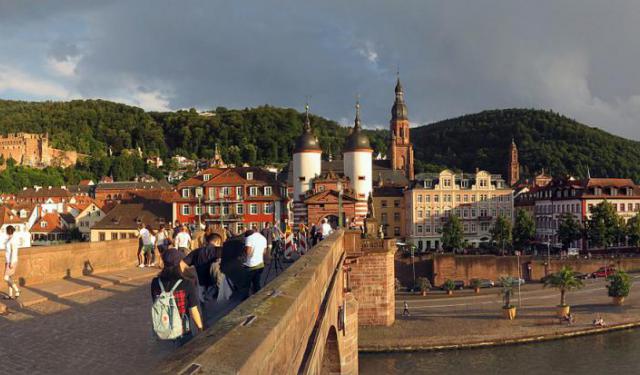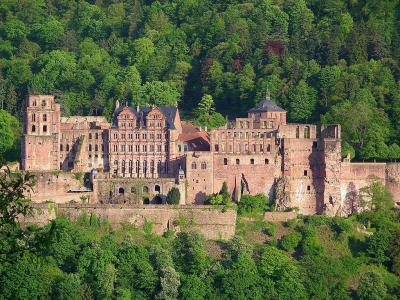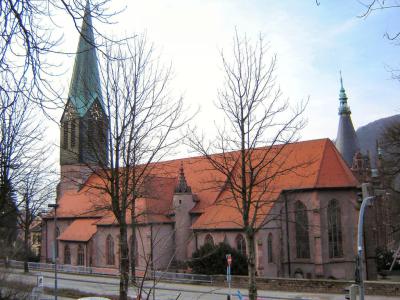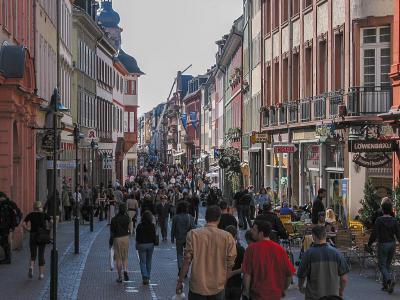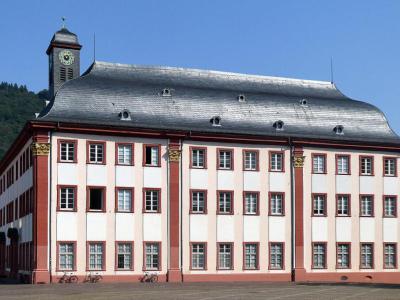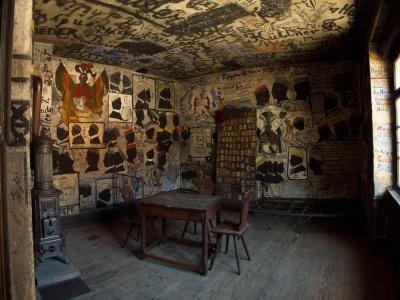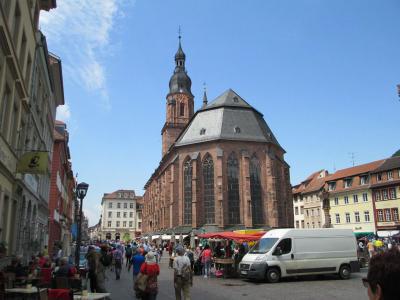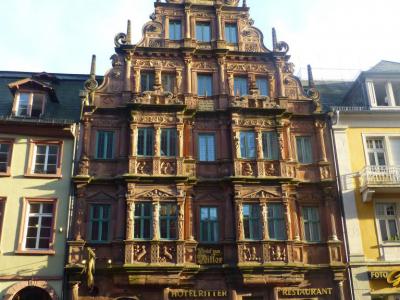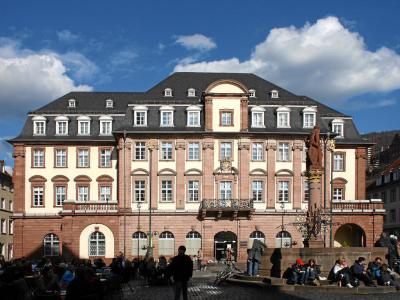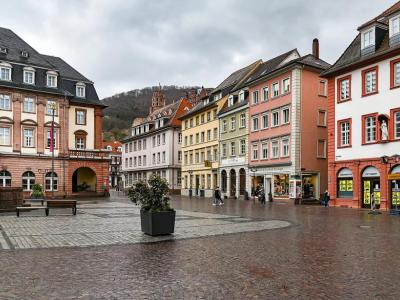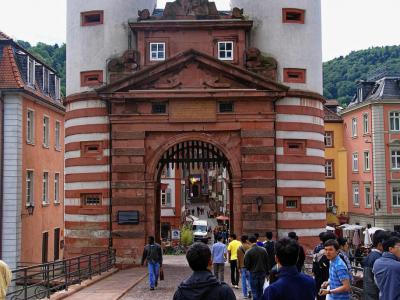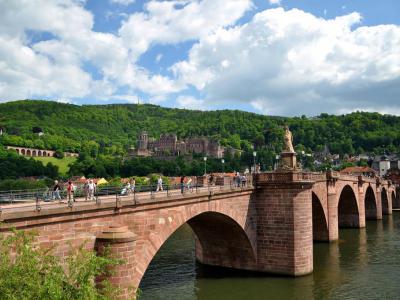Heidelberg Introduction Walking Tour (Self Guided), Heidelberg
Heidelberg is located on the Neckar River and is Baden-Württemberg’s fifth-largest city. One-quarter of the approximately 160,000 residents are students. Heidelberg University was founded in 1386 and is Germany’s oldest and one of Europe’s most prestigious universities. In addition, Heidelberg is home to internationally acclaimed research facilities, including four Max Planck Institutes. The UNESCO Creative Cities Network named Heidelberg a “City of Literature.”
Heidelberg has been a center of human habitation for millennia. In 1907, a jawbone from an ancient human was discovered nearby and is Europe’s earliest human artifact. A Celtic fortress was built in Heidelberg in the 5th century BC. The Romans built a wooden bridge and occupied the area from 40 AD to 260 AD.
The Bergheim village was established around 769 AD. Modern Heidelberg can be traced to the founding of the 12th-century Schonau Abbey. Throughout medieval times, Heidelberg was the seat of the Electorate of the Palatinate.
Heidelberg was involved in the damaging Thirty Years’ War from 1618 to 1648. This war was fought as part of the European wars of religion. The struggle was between Lutheran and Catholic states and a fight between Austria, Spain, and France for European domination. Heidelberg was sieged by enemy forces in 1622. The war finally ended when the Peace of Westphalia treaties were signed in 1648.
During the Nine Years’ War from 1688 to 1697, French troops attacked the Electoral Palatinate. Heidelberg Castle was set on fire twice during the Nine Years’ War. Heidelberg Castle remains in ruins but this beautiful location is Heidelberg’s top tourist destination.
The 1693 fire damaged most of Heidelberg’s buildings. The House of the Knight, originally built in 1592, was one of the few buildings that survived. The famous French writer Victor Hugo was particularly impressed by its beauty during his stay in Heidelberg in 1838. So will you.
Today’s visitors can explore Heidelberg University’s history by visiting the Old University Building and the Student Prison. Visit St. Peter’s Church and the Church of the Holy Spirit to immerse yourself in Heidelberg’s long religious history. Heidelberg is known for its cultural and community events, and its Main Street is one of Europe's oldest shopping streets.
Take this self-guided tour to explore Heidelberg’s most notable sights.
Heidelberg has been a center of human habitation for millennia. In 1907, a jawbone from an ancient human was discovered nearby and is Europe’s earliest human artifact. A Celtic fortress was built in Heidelberg in the 5th century BC. The Romans built a wooden bridge and occupied the area from 40 AD to 260 AD.
The Bergheim village was established around 769 AD. Modern Heidelberg can be traced to the founding of the 12th-century Schonau Abbey. Throughout medieval times, Heidelberg was the seat of the Electorate of the Palatinate.
Heidelberg was involved in the damaging Thirty Years’ War from 1618 to 1648. This war was fought as part of the European wars of religion. The struggle was between Lutheran and Catholic states and a fight between Austria, Spain, and France for European domination. Heidelberg was sieged by enemy forces in 1622. The war finally ended when the Peace of Westphalia treaties were signed in 1648.
During the Nine Years’ War from 1688 to 1697, French troops attacked the Electoral Palatinate. Heidelberg Castle was set on fire twice during the Nine Years’ War. Heidelberg Castle remains in ruins but this beautiful location is Heidelberg’s top tourist destination.
The 1693 fire damaged most of Heidelberg’s buildings. The House of the Knight, originally built in 1592, was one of the few buildings that survived. The famous French writer Victor Hugo was particularly impressed by its beauty during his stay in Heidelberg in 1838. So will you.
Today’s visitors can explore Heidelberg University’s history by visiting the Old University Building and the Student Prison. Visit St. Peter’s Church and the Church of the Holy Spirit to immerse yourself in Heidelberg’s long religious history. Heidelberg is known for its cultural and community events, and its Main Street is one of Europe's oldest shopping streets.
Take this self-guided tour to explore Heidelberg’s most notable sights.
How it works: Download the app "GPSmyCity: Walks in 1K+ Cities" from Apple App Store or Google Play Store to your mobile phone or tablet. The app turns your mobile device into a personal tour guide and its built-in GPS navigation functions guide you from one tour stop to next. The app works offline, so no data plan is needed when traveling abroad.
Heidelberg Introduction Walking Tour Map
Guide Name: Heidelberg Introduction Walking Tour
Guide Location: Germany » Heidelberg (See other walking tours in Heidelberg)
Guide Type: Self-guided Walking Tour (Sightseeing)
# of Attractions: 11
Tour Duration: 2 Hour(s)
Travel Distance: 2.0 Km or 1.2 Miles
Author: DanaOffice
Sight(s) Featured in This Guide:
Guide Location: Germany » Heidelberg (See other walking tours in Heidelberg)
Guide Type: Self-guided Walking Tour (Sightseeing)
# of Attractions: 11
Tour Duration: 2 Hour(s)
Travel Distance: 2.0 Km or 1.2 Miles
Author: DanaOffice
Sight(s) Featured in This Guide:
- Schloss Heidelberg (Heidelberg Castle)
- Peterskirche (St. Peter's Church)
- Hauptstrasse (Main Street)
- Alte Universitat (Old University Building)
- Studentenkarzer (Student Prison)
- Heiliggeistkirche (Church of the Holy Spirit)
- Haus zum Ritter (House of the Knight)
- Rathaus (Town Hall)
- Marktplatz (Market Square)
- Bruckentor (Bridge Gate)
- Alte Brucke (Old Bridge)
1) Schloss Heidelberg (Heidelberg Castle) (must see)
The romantic ruins of this old castle rise over the town, creating a picturesque scene. Built and expanded multiple times between the 13th and 17th centuries, it was originally a heavily fortified Gothic stronghold and the seat of the House of Wittelsbach palatines. In the 16th century, the complex was remodeled into one of Germany's most stunning residences, but its glory was short-lived due to the devastation of the Thirty Years' War and the 1689 war with France, during which most of the structure was destroyed and never rebuilt.
What's most striking here is the architectural variety. The oldest parts still standing date back to the 15th century, though most of the castle was built during the Renaissance in the 16th and 17th centuries when it was the seat of the Palatinate electors. There's an "English wing" built in 1612 by Elector Friedrich V for his teenage Scottish bride, Elizabeth Stuart; its plain, square-window facade stands out against other, more opulent styles. The architectural highlight remains the Renaissance courtyard-harmonious, graceful, and ornate.
Even if you have to wait, make a point of seeing the two-story Great Cask ("Grosses Fass") in the cellar, possibly the world's largest wine barrel, made from 130 oak trees and capable of holding 58,500 gallons. It was used to store wines paid as taxes by wine growers in the Palatinate. Also included in your ticket is the German Pharmacy Museum ("Apotheken-Museum"), where you can see six re-created apothecaries dating back as far as the 17th century, complete with a collection of books, medical instruments and medicine bottles.
In summer there are fireworks displays, on the first Saturday in June and September and the second Saturday in July, to commemorate when the castle went up in flames in 1689, 1693, and 1764 (two of the fires happened during wars with the French, and the last one was caused by lightning). June and July also feature a theater festival, with performances of "The Student Prince" often taking center stage.
Tip:
Skip the hike up the Burgweg and take the Königstuhl Bergbahn (funicular) instead-it's faster and less tiring!
What's most striking here is the architectural variety. The oldest parts still standing date back to the 15th century, though most of the castle was built during the Renaissance in the 16th and 17th centuries when it was the seat of the Palatinate electors. There's an "English wing" built in 1612 by Elector Friedrich V for his teenage Scottish bride, Elizabeth Stuart; its plain, square-window facade stands out against other, more opulent styles. The architectural highlight remains the Renaissance courtyard-harmonious, graceful, and ornate.
Even if you have to wait, make a point of seeing the two-story Great Cask ("Grosses Fass") in the cellar, possibly the world's largest wine barrel, made from 130 oak trees and capable of holding 58,500 gallons. It was used to store wines paid as taxes by wine growers in the Palatinate. Also included in your ticket is the German Pharmacy Museum ("Apotheken-Museum"), where you can see six re-created apothecaries dating back as far as the 17th century, complete with a collection of books, medical instruments and medicine bottles.
In summer there are fireworks displays, on the first Saturday in June and September and the second Saturday in July, to commemorate when the castle went up in flames in 1689, 1693, and 1764 (two of the fires happened during wars with the French, and the last one was caused by lightning). June and July also feature a theater festival, with performances of "The Student Prince" often taking center stage.
Tip:
Skip the hike up the Burgweg and take the Königstuhl Bergbahn (funicular) instead-it's faster and less tiring!
2) Peterskirche (St. Peter's Church)
A popular photo spot for tourists, Saint Peter's is the oldest surviving church in Heidelberg's Old Town. Originally built in the 12th century in the Romanesque style, it predates the foundation of Heidelberg itself. Renovated in the late 15th century, it gained a Gothic-style tower and chapel; however, after being destroyed during the Nine Years' War, it was rebuilt in baroque style in the early 18th century.
Between 1863 and 1870, the church underwent a neo-Gothic conversion and expansion. Adjacent is an ancient cemetery with graves and monuments over 500 years old, including one belonging to the poet Olympia Fulvia Morata, who died in 1555.
Interestingly, the structure has 90 epitaphs inside and 66 on the outside walls. In 2004, a major renovation of the interior included a new altar, pulpit, baptismal font, Easter candlestick, and a free-standing cross in the choir, made from COR-TEN steel. In July 2006, four new church windows by glass artist Johannes Schreiter were installed. Three windows in the University Chapel feature themes of "encounter", "resurrection", and "persecution", while in the northern side-chapel, used for prayer and meditation, there is a window themed "peace". In March 2008, a modern sculpture of Jesus by Korean artist Lee Choon-Mann was added.
In 2010, three large windows – Holy Spirit" and "Baptism" on the north side and "Heavenly Jerusalem" on the south side, along with two smaller windows themed "Worth" and "Sacrament" – were installed, completing a cycle of nine windows.
The interior regularly hosts exhibitions and concerts, with acoustics that are truly amazing.
Between 1863 and 1870, the church underwent a neo-Gothic conversion and expansion. Adjacent is an ancient cemetery with graves and monuments over 500 years old, including one belonging to the poet Olympia Fulvia Morata, who died in 1555.
Interestingly, the structure has 90 epitaphs inside and 66 on the outside walls. In 2004, a major renovation of the interior included a new altar, pulpit, baptismal font, Easter candlestick, and a free-standing cross in the choir, made from COR-TEN steel. In July 2006, four new church windows by glass artist Johannes Schreiter were installed. Three windows in the University Chapel feature themes of "encounter", "resurrection", and "persecution", while in the northern side-chapel, used for prayer and meditation, there is a window themed "peace". In March 2008, a modern sculpture of Jesus by Korean artist Lee Choon-Mann was added.
In 2010, three large windows – Holy Spirit" and "Baptism" on the north side and "Heavenly Jerusalem" on the south side, along with two smaller windows themed "Worth" and "Sacrament" – were installed, completing a cycle of nine windows.
The interior regularly hosts exhibitions and concerts, with acoustics that are truly amazing.
3) Hauptstrasse (Main Street)
Heidelberg's Hauptstrasse is one of Europe's oldest, longest, and most beloved shopping avenues. Spanning 1.4 kilometers through the picturesque Old Town, this fully pedestrianized throroughfare links the busy Market Square with Bismarck Square. As you stroll along, you'll pass important landmarks like the Town Hall and a plethora of boutique shops.
Even before Heidelberg was founded, a small traffic route traced the path of what is now the Main Street. In the 14th century, it was expanded to its current length, with gates at each end. At the eastern end, you can see the Karlstor gate, which replaced the original gate in the 1700s and resembles a Roman triumphal arch, guarded by two lion statues.
Now considered one of Europe's most beautiful pedestrian zones, Hauptstrasse hosts arts and crafts markets and major city events such as the Heidelberg Half Marathon. Shopaholics will delight in the diverse array of offerings, from global fashion brands to quaint specialty stores, all distinguished by their attentive customer service.
When you need a break from the shopping and sightseeing, there are plenty of cafés and ice cream parlors to relax in. Especially in the summer, you can sit outside, enjoy a cool ice cream or a slice of cake, and watch the lively activity before resuming your exploration.
Even before Heidelberg was founded, a small traffic route traced the path of what is now the Main Street. In the 14th century, it was expanded to its current length, with gates at each end. At the eastern end, you can see the Karlstor gate, which replaced the original gate in the 1700s and resembles a Roman triumphal arch, guarded by two lion statues.
Now considered one of Europe's most beautiful pedestrian zones, Hauptstrasse hosts arts and crafts markets and major city events such as the Heidelberg Half Marathon. Shopaholics will delight in the diverse array of offerings, from global fashion brands to quaint specialty stores, all distinguished by their attentive customer service.
When you need a break from the shopping and sightseeing, there are plenty of cafés and ice cream parlors to relax in. Especially in the summer, you can sit outside, enjoy a cool ice cream or a slice of cake, and watch the lively activity before resuming your exploration.
4) Alte Universitat (Old University Building) (must see)
Heidelberg proudly hosts Germany's oldest university, founded in the 14th century. Among its most beautiful buildings is the Alte Universität ("Old University"), nestled in the Old Town. The name can be a bit misleading, as the current structure was completed in 1735, replacing the original that was razed during the Palatine War of Succession in 1693. Step inside to discover the Alte Aula, a splendid 19th-century assembly hall adorned with allegorical paintings by Ferdinand Keller on its north wall and ceiling.
At the fore of the Old University is a square with a fountain topped by a sculpture of the heraldic Palatinate lion. For centuries, this fountain was one of Heidelberg's main drinking water sources. The square itself was built over the remains of an Augustinian monastery that did not survive the year 1693, when French troops took the town and castle, bringing nearly total destruction to the area.
Today, the Old University building serves as a venues for diverse events and houses the University Museum, which showcases the illustrious history of this renowned German institution from its inception to the present day. A single ticket grants access not only to the museum, but also to the Alte Aula and the intriguing Student Prison at the rear, accessed via Augustinergasse.
At the fore of the Old University is a square with a fountain topped by a sculpture of the heraldic Palatinate lion. For centuries, this fountain was one of Heidelberg's main drinking water sources. The square itself was built over the remains of an Augustinian monastery that did not survive the year 1693, when French troops took the town and castle, bringing nearly total destruction to the area.
Today, the Old University building serves as a venues for diverse events and houses the University Museum, which showcases the illustrious history of this renowned German institution from its inception to the present day. A single ticket grants access not only to the museum, but also to the Alte Aula and the intriguing Student Prison at the rear, accessed via Augustinergasse.
5) Studentenkarzer (Student Prison)
As Heidelberg University flourished since its founding in 1386, the antics of its students grew notorious. By the 16th century, exasperated city dwellers found themselves at wit's end with the rowdy behavior. In response, the University devised a novel solution: their own prison to curb the mischief. The student lockup shifted several locations, with the current one, open to visitors, in use from 1823 to 1914.
For offenses ranging from drunken revelry and streetlamp shenanigans to more egregious acts like pig chases, students could find themselves sentenced to up to two weeks in the confines of this small detention center. Graver transgressions could earn a stint of up to four weeks. Yet, rather than being a deterrent, serving time in the student slammer became a badge of honor, a rite of passage.
Although students were technically permitted to attend classes during their confinement, many opted to skip lectures, instead passing the hours crafting verse or leaving their mark on the walls with graffiti and candle-soot sketches. Today, these historical remnants-graffiti on walls, above doorways, and on the ceiling-offer a fascinating glimpse into the mischievous spirit of Heidelberg's past scholars.
For offenses ranging from drunken revelry and streetlamp shenanigans to more egregious acts like pig chases, students could find themselves sentenced to up to two weeks in the confines of this small detention center. Graver transgressions could earn a stint of up to four weeks. Yet, rather than being a deterrent, serving time in the student slammer became a badge of honor, a rite of passage.
Although students were technically permitted to attend classes during their confinement, many opted to skip lectures, instead passing the hours crafting verse or leaving their mark on the walls with graffiti and candle-soot sketches. Today, these historical remnants-graffiti on walls, above doorways, and on the ceiling-offer a fascinating glimpse into the mischievous spirit of Heidelberg's past scholars.
6) Heiliggeistkirche (Church of the Holy Spirit)
With public spectacles of punishment a thing of the past, crowds now gather over beer and coffee at the focal Market Square, or Marktplatz. At its core stands the 15th-century Gothic Church of the Holy Spirit, featuring a Baroque mansard roof that ingeniously accommodates traders' stalls between its buttresses, continuing a medieval tradition once widespread across the land.
An intriguing aspect of this grand church is its longstanding shared use by Catholics and Protestants, a tradition dating back centuries, even after its official conversion to Protestantism in 1936. The gargoyles on its southern side (where Hauptstrasse meets Marktplatz) are strikingly grotesque, yet the tower rewards climbers with fantastic city views, while the glorious organ steals the show during concerts.
History hasn't been very kind to this venerable edifice. Plundered by the Catholic League during the tumultuous Thirty Years' War, it lost its greatest treasure-the Bibliotheca Palatina, then Germany's largest library-loaded onto 500 carts and taken to the Vatican, with only a fraction ever returning. Then, in the late 17th century, marauding French troops ravaged the church once more, leaving many tombs in ruins; only the 15th-century tomb of Elector Ruprecht III and his wife, Elisabeth von Hohenzollern, stands intact. Amidst the chaos, the lone survivor was the House of the Knight across the square.
An intriguing aspect of this grand church is its longstanding shared use by Catholics and Protestants, a tradition dating back centuries, even after its official conversion to Protestantism in 1936. The gargoyles on its southern side (where Hauptstrasse meets Marktplatz) are strikingly grotesque, yet the tower rewards climbers with fantastic city views, while the glorious organ steals the show during concerts.
History hasn't been very kind to this venerable edifice. Plundered by the Catholic League during the tumultuous Thirty Years' War, it lost its greatest treasure-the Bibliotheca Palatina, then Germany's largest library-loaded onto 500 carts and taken to the Vatican, with only a fraction ever returning. Then, in the late 17th century, marauding French troops ravaged the church once more, leaving many tombs in ruins; only the 15th-century tomb of Elector Ruprecht III and his wife, Elisabeth von Hohenzollern, stands intact. Amidst the chaos, the lone survivor was the House of the Knight across the square.
7) Haus zum Ritter (House of the Knight)
Heidelberg's oldest standing residential building, originally built in 1592, is notable for being the only structure that withstood the 1693 fire and the destruction caused by the French. Its flamboyant Renaissance facade, crafted from stone, is an uncharacteristic extravagance by Charles Belier, a French textile merchant who relocated here because he was a Calvinist. Due to its survival, the building served as the town hall from 1693 to 1703. In 1705, it was turned into the Inn to the Knight Saint George, a role it has clung to ever since.
Renowned French wordsmith Victor Hugo, on a jaunt to Heidelberg in 1838, was thoroughly impressed by this edifice's resilience and grandeur. Among its various Latin inscriptions, one whimsically decrees, "May beauty remain undefeated", while another piously declares, "Glory to God alone". A longer inscription translates to, "Unless the Lord builds the house, the builders work in vain". Oh, and watch out for the ram motif above the entrance-a cheeky nod to the Belier family, as "belier" is French for, you guessed it, ram!
Renowned French wordsmith Victor Hugo, on a jaunt to Heidelberg in 1838, was thoroughly impressed by this edifice's resilience and grandeur. Among its various Latin inscriptions, one whimsically decrees, "May beauty remain undefeated", while another piously declares, "Glory to God alone". A longer inscription translates to, "Unless the Lord builds the house, the builders work in vain". Oh, and watch out for the ram motif above the entrance-a cheeky nod to the Belier family, as "belier" is French for, you guessed it, ram!
8) Rathaus (Town Hall)
Situated prominently on the lively Market Square, the Town Hall has long been the nucleus of local governance and the epicenter of municipal affairs. Its genesis traces back to 1701, emerging anew from the ashes left by the French onslaught during the Nine Years' War, which razed its predecessor. The grand Baroque-style structure bears an imposing coat of arms crafted by Hungarian sculptor Heinrich Charrasky, who also sculpted the Hercules statue crowning the fountain at the square's center.
Over the years, the Town Hall has witnessed a series of metamorphoses and enhancements. In the late 1880s, the stately Neo-Renaissance north wing was appended, bedecked with captivating paintings and stained glass windows chronicling the annals of Palatinate history by the adept brush of artist Karl Hoffacker. A conflagration in 1908 spurred further expansion, culminating in the addition of the Neo-Baroque south wing, while the erstwhile tower alongside the main façade was eventually dismantled, its lower tiers assimilated into the architectural tapestry. A more recent modification in 1961 birthed the regal bell tower on the east façade.
An annual highlight is the official inauguration of the Christmas market, celebrated from the Town Hall's balcony, where the main façade is decorated with festive illuminations. Additionally, on "Pink Monday" following the first Advent, the building is bathed in a rosy glow.
Over the years, the Town Hall has witnessed a series of metamorphoses and enhancements. In the late 1880s, the stately Neo-Renaissance north wing was appended, bedecked with captivating paintings and stained glass windows chronicling the annals of Palatinate history by the adept brush of artist Karl Hoffacker. A conflagration in 1908 spurred further expansion, culminating in the addition of the Neo-Baroque south wing, while the erstwhile tower alongside the main façade was eventually dismantled, its lower tiers assimilated into the architectural tapestry. A more recent modification in 1961 birthed the regal bell tower on the east façade.
An annual highlight is the official inauguration of the Christmas market, celebrated from the Town Hall's balcony, where the main façade is decorated with festive illuminations. Additionally, on "Pink Monday" following the first Advent, the building is bathed in a rosy glow.
9) Marktplatz (Market Square) (must see)
Heidelberg's main square, flanked by the Town Hall ("Rathaus") and the impressive Church of the Holy Spirit ("Heiliggeistkirche"), has been the city's focal point since medieval times. In earlier centuries, it served as the stage for public trials and the grim spectacles of witch burnings and heresy condemnations.
At the heart of the square stands the baroque Hercules Fountain, a testament to the city's resilience in the aftermath of the Thirty Years' War. Crafted by 18th-century artist Heinrich Charrasky, the fountain commemorates the Herculean efforts undertaken to rebuild Heidelberg. Adjacent to it once stood a rotating, hanging cage, serving as a stark reminder of past punishment practices. Those guilty of lesser offenses were incarcerated within, subjected to the scorn of their fellow citizens.
Today, the area bustles with activity, hosting outdoor markets every Wednesday and Saturday. Numerous eateries and cafes line its perimeter, many offering al fresco dining options to soak in the atmosphere. While here, don't miss the opportunity to ascend the church tower for a beautiful panoramic view of the surroundings, available for a small fee.
At the heart of the square stands the baroque Hercules Fountain, a testament to the city's resilience in the aftermath of the Thirty Years' War. Crafted by 18th-century artist Heinrich Charrasky, the fountain commemorates the Herculean efforts undertaken to rebuild Heidelberg. Adjacent to it once stood a rotating, hanging cage, serving as a stark reminder of past punishment practices. Those guilty of lesser offenses were incarcerated within, subjected to the scorn of their fellow citizens.
Today, the area bustles with activity, hosting outdoor markets every Wednesday and Saturday. Numerous eateries and cafes line its perimeter, many offering al fresco dining options to soak in the atmosphere. While here, don't miss the opportunity to ascend the church tower for a beautiful panoramic view of the surroundings, available for a small fee.
10) Bruckentor (Bridge Gate)
Framing the entrance to the Old Bridge or serving as a picturesque backdrop with the Old Town in the distance, this imposing structure is a true Heidelberg landmark. Originally part of the city's defensive walls, it has stood guard at the northern entrance for centuries, weathering ice floes and fires that ravaged earlier bridges. Close inspection reveals flood marks left by various deluges over the years.
Functioning as both a defensive bastion and a toll collection point, the gate could be securely shut during times of attack, while foreigners seeking passage across the Old Bridge were required to pay a toll. Additionally, it housed guards and even served as a jail, with the eastern tower featuring a spiral staircase leading to the bridge keeper's living quarters, and the western tower containing three detention rooms. Standing at 28 meters (92 feet) tall, these towers miraculously survived the destruction wrought by the French conquest in 1689. In 1788, their original tops replaced with elegant Baroque-style spires.
Today, the gate exudes an unmistakable medieval charm, inviting visitors to step back in time as they meander through Heidelberg's Old Town. For a truly enchanting experience, take a romantic stroll around dusk, and don't forget your camera to capture the views of the Neckar River, the mountains, Heidelberg Castle, and the Old Bridge.
Functioning as both a defensive bastion and a toll collection point, the gate could be securely shut during times of attack, while foreigners seeking passage across the Old Bridge were required to pay a toll. Additionally, it housed guards and even served as a jail, with the eastern tower featuring a spiral staircase leading to the bridge keeper's living quarters, and the western tower containing three detention rooms. Standing at 28 meters (92 feet) tall, these towers miraculously survived the destruction wrought by the French conquest in 1689. In 1788, their original tops replaced with elegant Baroque-style spires.
Today, the gate exudes an unmistakable medieval charm, inviting visitors to step back in time as they meander through Heidelberg's Old Town. For a truly enchanting experience, take a romantic stroll around dusk, and don't forget your camera to capture the views of the Neckar River, the mountains, Heidelberg Castle, and the Old Bridge.
11) Alte Brucke (Old Bridge) (must see)
The Old Bridge spans the Neckar River, linking the Old Town with the newer eastern part of the city. Although built in 1788, it is actually one of Heidelberg's newer structures. Historically, there have been eight bridges in this location, with the current one constructed on the foundations of its predecessors. When the Theodor Heuss Bridge was built in 1877, this became known as the "Old Bridge".
The first bridge at this site was built by the Romans in the 1st century, but it collapsed, and it took nearly 1000 years to replace it. A new crossing was constructed in the 13th century when Heidelberg was founded, aligning with its present location near the marketplace. Goethe hailed its beauty as "not equalled by any other in the world", and it certainly provides a classic vista.
In the early days, the Old Bridge marked the border with the Electorate of Mainz and was part of the city's defenses. Several of its early versions were destroyed by ice floes; the seventh survived the Thirty Years' War but was destroyed during the Nine Years' War. The current nine-arch bridge, built with distinctive red sandstone, was completed thereafter, featuring an ancient gate, two towers, and statues of Prince Karl-Theodor and Minerva. During the Second World War, three of its arches were destroyed, and had to be rebuilt.
A monkey statue has been a part of the bridge since the 15th century and remains a tourist attraction. The original statue disappeared during the Nine Years' War and was later replaced; the current one depicts a monkey holding a mirror in one hand. Tourists often place their heads inside the monkey's head, rub the monkey's mirror for luck, and touch its fingers to ensure a return to Heidelberg.
The first bridge at this site was built by the Romans in the 1st century, but it collapsed, and it took nearly 1000 years to replace it. A new crossing was constructed in the 13th century when Heidelberg was founded, aligning with its present location near the marketplace. Goethe hailed its beauty as "not equalled by any other in the world", and it certainly provides a classic vista.
In the early days, the Old Bridge marked the border with the Electorate of Mainz and was part of the city's defenses. Several of its early versions were destroyed by ice floes; the seventh survived the Thirty Years' War but was destroyed during the Nine Years' War. The current nine-arch bridge, built with distinctive red sandstone, was completed thereafter, featuring an ancient gate, two towers, and statues of Prince Karl-Theodor and Minerva. During the Second World War, three of its arches were destroyed, and had to be rebuilt.
A monkey statue has been a part of the bridge since the 15th century and remains a tourist attraction. The original statue disappeared during the Nine Years' War and was later replaced; the current one depicts a monkey holding a mirror in one hand. Tourists often place their heads inside the monkey's head, rub the monkey's mirror for luck, and touch its fingers to ensure a return to Heidelberg.
Walking Tours in Heidelberg, Germany
Create Your Own Walk in Heidelberg
Creating your own self-guided walk in Heidelberg is easy and fun. Choose the city attractions that you want to see and a walk route map will be created just for you. You can even set your hotel as the start point of the walk.
Philosophers’ Path
Heidelberg may be famous for its Castle, Old Town, and University, but its attractions don't stop there. A trip to Heidelberg isn't complete without visiting the Philosopher's Path.
Located on the northern side of the Neckar River, this popular path, about two kilometers long, meander along the sunny side of Holy Mountain. Over the centuries, it has inspired numerous scholars and... view more
Tour Duration: 1 Hour(s)
Travel Distance: 1.6 Km or 1 Miles
Located on the northern side of the Neckar River, this popular path, about two kilometers long, meander along the sunny side of Holy Mountain. Over the centuries, it has inspired numerous scholars and... view more
Tour Duration: 1 Hour(s)
Travel Distance: 1.6 Km or 1 Miles
The Most Popular Cities
/ view all
